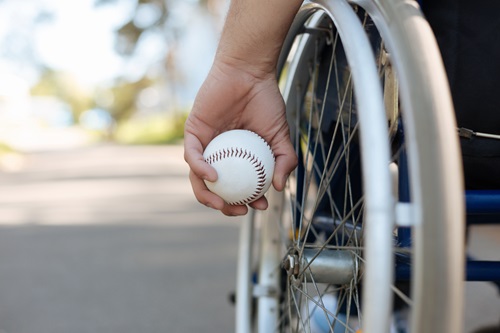
An updated Milwaukee County park, hailed as the country’s first fully universal park for users of all abilities, will include opportunities for play, recreation and competition when it opens in phases beginning later this summer.
The 18-acre Wisconsin Avenue Park in Wauwatosa has been renamed Moss Universal Park and is undergoing a $12 million overhaul designed to — in the words of The Ability Center, the Milwaukee-based nonprofit organization dedicated to universally inclusive recreation that is leading the project — create new opportunities for “everyBODY.” That includes beyond the edge of the playground, which will be loaded with accessible equipment.
The universally inclusive clubhouse, for example, is designed to encourage people with disabilities to stay and play all day long, with restrooms equipped with adult changing stations and power to recharge wheelchairs, plus medical devices and communication devices. A Level I trauma center and a Ronald McDonald House are located nearby, too. A paved trail will loop through the park’s woods, “play pockets” will encourage spontaneous play while “fitness pockets” will allow people of all ages and abilities to exercise, and Sensory Valley will offer people with mental health or sensory challenges the opportunity to quietly escape with nature.
Another highlight of Moss Park will be a baseball field that a brochure declares will “become a universal field for nearly every sport,” including Miracle Leagues, wheelchair football and wheelchair lacrosse. “Adaptive athletes will no longer have to play in parking lots.”
Developers even envision athletes of all abilities competing side-by-side — like “a high school baseball game … alongside a Miracle League baseball game,” Damian Buchman, founder and executive director of The Ability Center, told WUWM.com. “People are connecting together, seeing one another and seeing what their capabilities and their abilities really are.”
 The Ability Center notes that 26% of people in the United States report having a disability, including one in four Wisconsinites.
The Ability Center notes that 26% of people in the United States report having a disability, including one in four Wisconsinites.
“What we often do is build inclusive playgrounds, but every playground is in a park, and every entire park should be inclusive,” Buchman added, speaking to CBS58.com. “Access does not mean opportunity, and opportunity is where it really matters, and so we’re trying to give everybody that opportunity to play together. We help those with disabilities play together with those they love most.”
Nearly 35 years after passage of the Americans with Disabilities Act, access to some parks and other outdoor areas remains minimal for people for whom the law was most intended to help.
“These issues exist on public lands like national parks, too,” writes Nicole Segnini, who covers diversity issues for The Wilderness Society. “Despite laws like the Americans with Disabilities Act (ADA) and Architectural Barriers Act (ABA), which requires federally funded facilities and outdoor areas to be accessible to people with disabilities, there is still a long way to go for people with disabilities to have full access — let alone feel fully welcome. Common problems include old infrastructure, budget constraints, natural and rugged terrain and lack of awareness or insensitivity from other visitors.”
To that end, the Great Smoky Mountains National Park (which spans parts of both North Carolina and Tennessee) partnered last year with various organizations to offer three hikes and one mountain bike ride with adaptive gear. And this summer, between June and October, the park will offer seven opportunities. They include three hikes, two mountain bike rides, one kayak trip and one night of camping.
“These ranger-led tours promise an enriching experience for visitors of all abilities and their families, allowing them to immerse themselves in the natural and cultural treasures of this magnificent park,” according to the website for Catalyst Sports, which provides equipment for the excursions.
“Agencies need to continue developing accessible trails, boardwalks and pathways with appropriate slopes and surfaces; install ramps, handrails and curb cuts to enable wheelchair access; and ensure there are accessible parking spaces, restrooms and picnic areas,” Segnini writes. “[But] it’s not just about developing ramps and better park maps. We also need to transform outdoors culture and combat more subtle forms of ableism. For instance, media about sports and outdoor recreation should reflect a fuller array of bodies and abilities. Despite positive steps like the Paralympics shown on TV and other media, people with disabilities simply aren’t a prominent part of the narrative about who gets to enjoy the outdoors, potentially discouraging those who might otherwise give it a try.”

